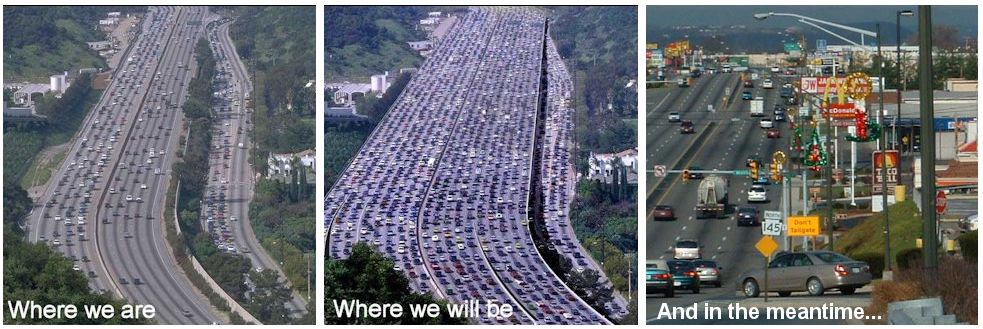How to Tame Your Dragon, Freeway Edition
Mike Brown is a transportation engineer and sponsor of Strong Towns through his firm, Metro Analytics. Today, he's sharing a guest article with some ideas for taming highway expansion.
For fun, think of freeways as akin to dragons…
(Collage assembled by Metro Analytics. Left image courtesy of philip.greenspun.com. Others are public domain.)
Life-Support Dragons are freeways with weak claims on continued existence: falling apart, under-utilized and obstructing beneficial infill. There are credible alternatives for managing existing traffic if these freeways were to be downsized or eliminated. In these cases, let them “die with dignity” rather than waste good money to keep them alive. CNU publishes Freeways without Futures with several in this category.
Yet-to-be-Born Dragons are future freeways that have a measure of support. Some have better cases for birth than others. Strong Towns has fought against a ridiculous one in Shreveport. However, there are other proposals with strong cases, such as in regions that may soon double in population. While I’m a fan of #NoNewRoads, I’m still practical and understand you could easily marginalize yourself trying to convince your region to forego what the great majority perceive as a critically needed project. If you’re bound to lose on the birth of a new freeway, try to reduce the odds that it will ever become a super-sized, money-consuming, infrastructure inducing, fire-breathing dragon. Bridle it from birth with congestion pricing or as a tollway, to limit induced fringe infrastructure and demand.
Fire Breathing Dragons: While never easy to kill any dragon, it is “comparatively easy” to take a wrong-fit, under-utilized freeway off life support, or to kill or bridle a new freeway on which no one is yet dependent. But what about today’s huge freeways that are crawling at 5 pm despite recent widening? What do you do about the “engineering industrial complex” that advocates another round of serious spaghetti? How do you manage a dragon’s obesity when it threatens to burn you alive unless you put your grandkids in hock to feed it junk food? There are many strategies, but let’s focus on four low-cost/high-return ideas.
Tools & Methods for Taming Fire-Breathing Freeway-Dragons
1. First Tame Yourself
Not a fan of freeways? Think regions would have been better off without them? Concerned their continued existence will exacerbate climate change? Ok, but here’s a cold stark fact: The biggest will exist for a long time, whether they should have or not. For a freeway under pressure to super-size, hone your language and change your goal. Today’s fight is not about downsizing. It’s about endless upsizing. Reasonable citizens want to find a way out of upsizing, but they also want to get around. Condemning all freeways as pure evil will cause the majority who see them as a necessary evil to marginalize you. Accept their present size as a necessary evil, and instead focus on matching demand to existing supply.
I-80 near Berkeley, CA. Isn’t this big enough? Demand says no, but good sense says there’s got to be a reasonable alternative to “bigger”. (Source: https://en.wikipedia.org/wiki/Traffic)
2. Promote Managed Motorways
When freeways collapse to stop-n-go, it’s worse than just slow. Throughput also drops dramatically. Freeways can carry a flow rate of roughly 2,200 vehicles per hour per lane – for about 10-minutes. In other words, they never actually carry their full potential (a fact overlooked by most regional travel demand models). During that 10-minutes, when there are no gaps for entering traffic, break-lights come on as new traffic attempts to fit. The result is a stop-n-go wave that causes throughput to drop from 2,200 to as low as 800 to 1,500.
Managing input works better than dumping “cars” into freeway all at once. (Source: UDOT Managed Motorways, YouTube demo)
Traditional ramp meters organize flow, but do not prevent overload. Managed Motorways is a process of installing sensors so computers can detect when the mainline is approaching overload, then ramp meters are automatically adjusted to prevent overload. That ensures the system can “hover” permanently at 95% efficiency, instead of hitting 100% for a short time, only to then collapse to 40-70% efficiency for the next three hours.
It is true that to hover at 95%, average wait times at on-ramps will increaseThat can be concerning to the public, until they realize an extra 5 minutes at the on-ramp can save them 30-minutes of stop-n-go delay. Some DOTs explain it with a visual experiment in public meetings, where they dump rice or pasta into a funnel all at once, vs. pouring it in slowly. If the rice comes in too fast, it plugs up, requiring finger-taps to get it going again. The metered side can fill 3-5 cups before the congested side fills even one.
Managed Motorways is a way to expand throughput without expanding lanes. But it’s only a half-step: It delays expensive widening, but it also induces demand and accelerates fringe development, just as more lanes would have. So let's take a look at the next weapon in your arsenal against dragons!
3. Articulate the Economic Benefits of Congestion Pricing
People line up for blocks for a free hotdog, but watch what happens when charge a dollar. As Joe Cortright has pointed out with the Ohio River bridges in Kentucky, they are over-sized now that there’s a $2 charge for what used to be free. Where is it written in stone that we must build more? Instead, match demand to fixed supply through pricing – the same way demand is matched to limited supply at popular restaurants, championship games, first-release iPhones, and every other place where there are limits to what is available.
So far, congestion pricing has not proven politically possible in American cities. But as Malcom Gladwell noted in The Tipping Point, there are many things that seemed impossible, then suddenly became inevitable. I am confident pricing will “soon” catch on. Why? The inability to build more, the need for new revenue, technology improvements, overseas success, and discussion of public-private partnerships for infrastructure all advance the cause. But the real tipping point may be the competitive advantage that comes to the first region to embrace pricing.
Competitive advantage? Sure – it is not unreasonable to believe there could be truly substantial gains to a region’s productivity and overall business attractiveness if 24/7 reliable high-speed mobility for commercial and high-value vehicle trips could be permanently sustained. Plus, there are tax savings. Though pricing is criticized as a “double tax,” pricing + fuel tax would turn out to be cheaper than just a fuel tax, because fuel taxes would end up being raised to “build our way out of congestion” anew.
The bottom line is that distance-based pricing will make a region more economically competitive while increasing off-peak use, increasing transit use, and making infill development more attractive. What’s not to love?
4. Automated Vehicles Are Effective Against Dragons… Today!
Since they’re not here yet, how can AV’s be useful in taming today’s dragons? Because they promise to soon make super-sizing look foolish, which argues for delaying the super-size as long as possible via Managed Motorways, alternative investments, etc. If vehicles can travel safely with little space between, then max throughput can move from 2,200 to 3,000 or higher. Plus, 12-ft lanes might become 9-10 ft, allowing more lanes without construction. Plus, while there is reasonable concern that automated vehicles could induce even more demand (if everyone owns one and can be productive on long drives), it may be more likely that ride sharing apps will reduce direct ownership and increase auto occupancy.
For the sake of Strong Towns and fiscal sanity, we have got to avoid “Big Digs” (tunnels, double-deckers, and 23-lane freeways!) Hopefully these strategies can strengthen your heat shield, so you can enter the dragon’s lair (DOT-sponsored meetings and public debates), and come out stronger. Freeways will always be dragons, but we can tame them to serve our Strong Towns, instead of the other way around.
If you like this article, please share with your favorite social media network below.
(Top image source: Dayoung Lee)
Related stories
About the author
Mike Brown is a New Urbanist transportation engineer with new strategies to convert stroads into walkable boulevards. He hopes to stop the “build-our-way-out with freeways” temptation by taming freeways instead, or downsizing those that just don’t make sense to continue. Mike founded Metro Analytics to pursue those objectives. Metro sponsors InnovativeIntersections.org, where you can discover cutting-edge Place-Making methods for managing high-volumes of traffic at low speeds, and at the same time catalyze mixed-use development. Metro also sponsors StreetPlan.net, a free Complete Street cross-section development tool that follows ITE/CNU best practice guidelines. Mike is based in Salt Lake City, Utah.









Part of why we can't agree on constructive solutions to traffic congestion is that our basic mental model of what causes traffic is wrong. But what if we made a slight update to that model?